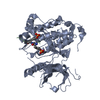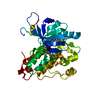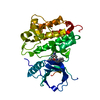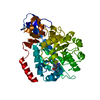Entry Database : PDB / ID : 4r3rTitle Crystal structures of EGFR in complex with Mig6 Epidermal growth factor receptor peptide from ERBB receptor feedback inhibitor 1' Keywords / / / / / Function / homology Function Domain/homology Component
/ / / / / / / / / / / / / / / / / / / / / / / / / / / / / / / / / / / / / / / / / / / / / / / / / / / / / / / / / / / / / / / / / / / / / / / / / / / / / / / / / / / / / / / / / / / / / / / / / / / / / / / / / / / / / / / / / / / / / / / / / / / / / / / / / / / / / / / / / / / / / / / / / / / / / / / / / / Biological species Homo sapiens (human)Method / / / Resolution : 3.25 Å Authors Park, E. / Kim, N. / Yi, Z. / Cho, A. / Kim, K. / Ficarro, S.B. / Park, A. / Park, W.Y. / Murray, B. / Meyerson, M. ...Park, E. / Kim, N. / Yi, Z. / Cho, A. / Kim, K. / Ficarro, S.B. / Park, A. / Park, W.Y. / Murray, B. / Meyerson, M. / Beroukim, R. / Marto, J.A. / Cho, J. / Eck, M.J. Journal : Nat.Struct.Mol.Biol. / Year : 2015Title : Structure and mechanism of activity-based inhibition of the EGF receptor by Mig6.Authors : Park, E. / Kim, N. / Ficarro, S.B. / Zhang, Y. / Lee, B.I. / Cho, A. / Kim, K. / Park, A.K. / Park, W.Y. / Murray, B. / Meyerson, M. / Beroukhim, R. / Marto, J.A. / Cho, J. / Eck, M.J. History Deposition Aug 17, 2014 Deposition site / Processing site Revision 1.0 Aug 12, 2015 Provider / Type Revision 1.1 Aug 26, 2015 Group Revision 1.2 Sep 16, 2015 Group Revision 1.3 Nov 27, 2024 Group Data collection / Database references ... Data collection / Database references / Derived calculations / Structure summary Category chem_comp_atom / chem_comp_bond ... chem_comp_atom / chem_comp_bond / database_2 / pdbx_entry_details / pdbx_modification_feature / struct_conn / struct_ref_seq_dif Item _database_2.pdbx_DOI / _database_2.pdbx_database_accession ... _database_2.pdbx_DOI / _database_2.pdbx_database_accession / _struct_conn.pdbx_leaving_atom_flag / _struct_ref_seq_dif.details
Show all Show less
 Open data
Open data Basic information
Basic information Components
Components Keywords
Keywords Function and homology information
Function and homology information Homo sapiens (human)
Homo sapiens (human) X-RAY DIFFRACTION /
X-RAY DIFFRACTION /  SYNCHROTRON /
SYNCHROTRON /  MOLECULAR REPLACEMENT / Resolution: 3.25 Å
MOLECULAR REPLACEMENT / Resolution: 3.25 Å  Authors
Authors Citation
Citation Journal: Nat.Struct.Mol.Biol. / Year: 2015
Journal: Nat.Struct.Mol.Biol. / Year: 2015 Structure visualization
Structure visualization Molmil
Molmil Jmol/JSmol
Jmol/JSmol Downloads & links
Downloads & links Download
Download 4r3r.cif.gz
4r3r.cif.gz PDBx/mmCIF format
PDBx/mmCIF format pdb4r3r.ent.gz
pdb4r3r.ent.gz PDB format
PDB format 4r3r.json.gz
4r3r.json.gz PDBx/mmJSON format
PDBx/mmJSON format Other downloads
Other downloads 4r3r_validation.pdf.gz
4r3r_validation.pdf.gz wwPDB validaton report
wwPDB validaton report 4r3r_full_validation.pdf.gz
4r3r_full_validation.pdf.gz 4r3r_validation.xml.gz
4r3r_validation.xml.gz 4r3r_validation.cif.gz
4r3r_validation.cif.gz https://data.pdbj.org/pub/pdb/validation_reports/r3/4r3r
https://data.pdbj.org/pub/pdb/validation_reports/r3/4r3r ftp://data.pdbj.org/pub/pdb/validation_reports/r3/4r3r
ftp://data.pdbj.org/pub/pdb/validation_reports/r3/4r3r Links
Links Assembly
Assembly
 Components
Components Homo sapiens (human) / Gene: EGFR, ERBB, ERBB1, Erbb1(EGFR), HER1 / Production host:
Homo sapiens (human) / Gene: EGFR, ERBB, ERBB1, Erbb1(EGFR), HER1 / Production host: 
 Homo sapiens (human) / References: UniProt: Q9UJM3
Homo sapiens (human) / References: UniProt: Q9UJM3 X-RAY DIFFRACTION / Number of used crystals: 1
X-RAY DIFFRACTION / Number of used crystals: 1  Sample preparation
Sample preparation SYNCHROTRON / Site:
SYNCHROTRON / Site:  APS
APS  / Beamline: 24-ID-E / Wavelength: 0.9792 Å
/ Beamline: 24-ID-E / Wavelength: 0.9792 Å Processing
Processing MOLECULAR REPLACEMENT / Resolution: 3.25→45.755 Å / SU ML: 0.42 / σ(F): 1.36 / Phase error: 23.47 / Stereochemistry target values: ML
MOLECULAR REPLACEMENT / Resolution: 3.25→45.755 Å / SU ML: 0.42 / σ(F): 1.36 / Phase error: 23.47 / Stereochemistry target values: ML Movie
Movie Controller
Controller















 PDBj
PDBj













